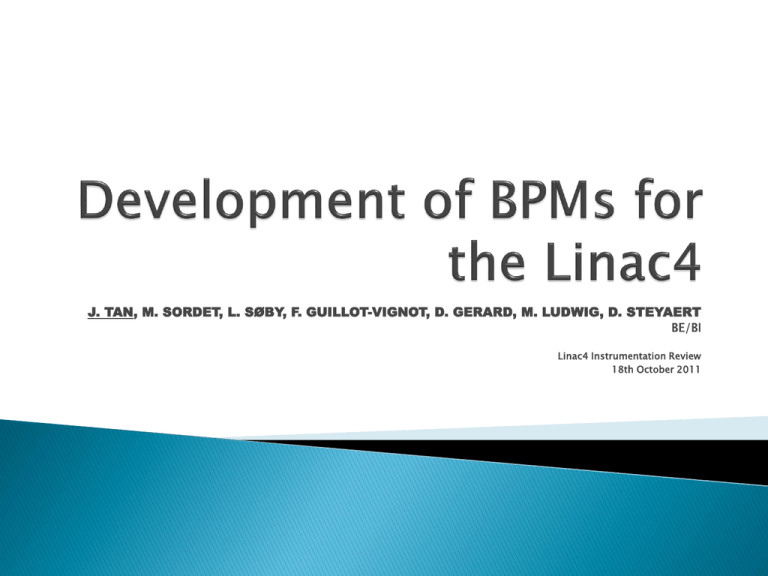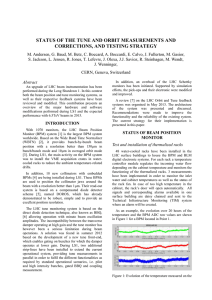2011-10-18_PU_ReviewV2
advertisement

J. TAN, M. SORDET, L. SØBY, F. GUILLOT-VIGNOT, D. GERARD, M. LUDWIG, D. STEYAERT BE/BI Linac4 Instrumentation Review 18th October 2011 BPM ◦ Layout ◦ Functional specs ◦ The monitor and low beta beams STATUS ◦ Drawings and prototyping ◦ BPM test bench and Acquisition chain ◦ First BPM characteristics ◦ Todo list Spare policy Planning Summary 3 MeV L4L 102 MeV 50 MeV ~ 12 m L4D ~18 m L4C ~22 m 160 MeV L4P ~14 m L4Z ~10 m Observable 1: Beam position Observable 2: Relative beam intensity between two BPMs Observable 3: Beam phase wrt RF reference Observable 4: Energy via TOF between two BPMs Beam position Line # of Monitors L4D 2 L4C 7 L4P 6 L4T to PSB 27 Resolution Accuracy 0.1mm 0.3mm Rel. Beam Int. Beam phase TOF 1% wrt to peak current 0.5 1 per mille Comments Shorted Stripline Linear Fair sensitivity Compact Reasonable price Resonating b-dependent Shorted Z0= 50 45 Movable test bench BPM Transfer impedance changes with b and bunch length b PU sensitivity changes with b These simulations confirm Shafer’s theorem (1994) The values obtained from the simulations will be implemented in the software Sensitivity at 352MHz BPM ◦ Layout ◦ Functional specs ◦ The monitor and low beta beams STATUS ◦ Drawings and prototyping ◦ BPM test bench and acquisition chain ◦ First BPM characteristics ◦ Todo list Spare policy Planning Summary L4L ~ 12 m L4D ~18 m L4C ~22 m L4P ~14 m L4Z ~10 m DTL •Beam aperture: 34 mm •Electrode length: 117 mm Quad CCDTL and PIMS •Beam aperture: 39 mm •Electrode length:117 mm TRANSFER LINE •Beam aperture: 100 mm •Electrode length:140 mm •Beam aperture: 34 mm •Electrode length: 72 mm 3 BPMs with welded feedthroughs onto the body 39 BPMs with feedthroughs mounted on CF flanges Modular commissioning of RFQ, MEBT and DTL tank1 •Transverse : profiles, emittances, halo, position •Longitudinal : transmission, av. energy, halo, DE/E, bunch phase spread Three BPMs •Beam aperture: 67 mm •Electrode length: 60 mm Electrode detail Feedthrough Body Feedthrough Issues During e- bombardment welding •Three feedthroughs affected by : Manufacturer’s procedure: glass-ceramic seal No sand blasting Ultrasonic cleaning +acetone rinsing before •Sparks •Material spray •Multi-pass welding needed Scanning electron microscopy •Standard 304 grade stainless steel •Surface not inlayed with dust particles •Traces of Si, Na, Mg, Ca Welded feedthroughs Wire technique w/ standing waves Optical sensor for mechanical centering : 0.01mm 352MHz sine wave with a N.A. Data acq by steps of 0.1mm Commissioning issues Black anodized coating =poor grounding. Solution : Improve grounding. Done Wire not terminated = Antenna Solution : terminate the wire by a short circuit. Done Optical rail : C-shape & 25mm cross section yield a lack of stiffness and 1mm electrical offset Solution : Swap to a full frame of 34mm cross section. Pending action. FEATURES U L R D LO A D C •Input Low pass filtering @1GHz •Down-mixing with LO •Variable gain with switchable attenuators •Band-pass filtering @22MHz •BPM Calibration Tcarrier =45.42ns 22.0125MHz Carrier Signal Clock jitter ~10ps VR, ADC IR QR –IR -QR Dx = VL, ADC time MR-ML MR+ML+MU+MD = beam - LO I = MR+ML+MU+MD TOF = PU2 - PU1 IL QL –IL -QL Beam aperture= 67mm Electrode length = 60mm THEORY H plane V plane Slope [mm] 40.32 41.79 s=0.42 41.02 s=0.56 Elec. Offset [mm] - -0.77 s=0.18 -0.19 s=0.13 Coupling w/ adjacent electrodes 7.3% 6.56 6.6 352MHz signal injected via the wire Measured voltages amplitudes from electrodes : ~65mV From the simulations, this is equivalent to a signal induced by a nominal beam of 1.14x109 H98 longitudinal phase (nearly debunched beam) Position (averaged over pulse length 740ms ~32k positions) Precision= 0.1mm Resolution = 0.1mm Resolution with few samples : to be done RF phase wrt LO Precision = 1 (room for improvement) Understand welding issues Improve stiffness of lab test bench Transfer impedance and characteristic impedance Resolution with short pulses Improve ADC clock jitter : the goal is ~200fs Commissioning of BPM calibration procedure Software : algorithm for I, Q, -I-Q determination Measurement with a pair of BPMs TOF Relative beam intensity Signal processing : Choose between SIS3302 (16bits – 13.4ENOB) : 6400CHF per board x25 FMC (14bits – 11.7ENOB) : Status ? 25 boards. Unknown final price BPM ◦ Layout ◦ Functional specs ◦ The monitor and low beta beams STATUS ◦ Drawings and prototyping ◦ BPM test bench and Acquisition chain ◦ First BPM characteristics ◦ Todo list Spare policy Planning Summary Monitors ◦ Movable Test Bench : 3 +2 spares for lab commissioning ◦ Linac : 15 + 11 spares (one per version) ◦ Transfer line : 27 + 2 spares ◦ TOTAL : 55 BPMs Acquisition chain ◦ Front end board : ◦ ADC or FMC : 45 + 15 spares 23 + 4 spares LS1 Start of TL construction & Installation Start of Machine Installation Start of Machine Commissioning Very encouraging results yet still a lot of work ahead of us. Ready for the Movable Test Bench commissioning Planning in phase with Linac4 installation and LS1 Budget sligthly underestimated : overrun by ~200kCHF …Questions ? Number of BPMs Beam Ap. [mm] Long. Phase [ rms] RMS length [ps] Movable test bench 3-12MeV DTL CCDTL PIMS 160MeV New TL -> LT.BHZ20 160MeV Old TL -> PSB 160MeV 50MeV 102MeV 3 2 7 6 10 17 67 34 / 39 39 39 100 100 6.4 /98 3 3 2.5 25 55 50 / 777 24 24 20 200 433 Bunch spacing : 2.84 ns Nominal beam phase width evolution (1RMS) MEBT Linac4 PSB strip. foil Sigma [ps] 200 20 433 Rel. beta 0.0798 0.52 0.52 Simulations with CST Particle Studio ◦ Multi-bunch ◦ Space charge effect ◦ Low b Power flow module Electric field module External diameter of the RF feedthrough is important Body gap 0.5mm C Electrode Capacitive effect : 9pF









